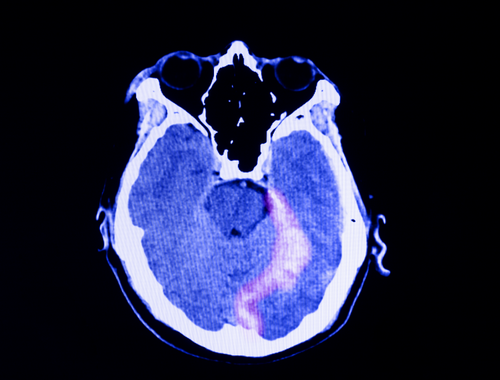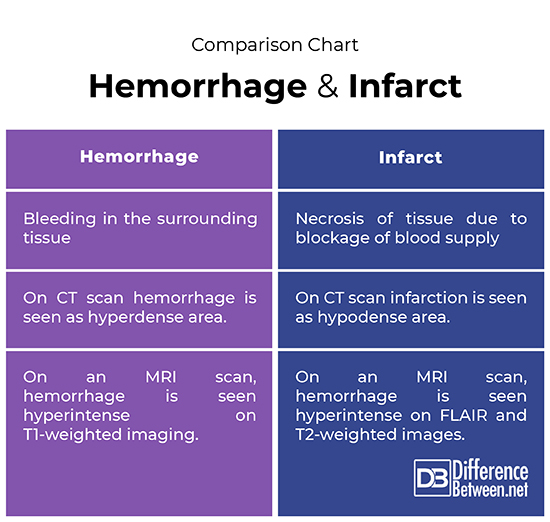Difference Between Hemorrhage and Infarct
Infarction is an injury or tissue death (necrosis) due to the absence or inadequate flow of blood to a specific area. Hemorrhage is the leakage of blood from the vasculature into the surrounding areas.

What is Hemorrhage?
Hemorrhage is heavy bleeding in a shorter time due to the damage in the blood vessel. Hemorrhage has two types which are internal hemorrhage and external hemorrhage.
In a brain hemorrhage the artery that supplies the affected area bursts, and the blood accumulates in the surrounding area. The condition becomes life-threatening or sometimes makes the patient life-long disabled.
Causes and risk factors
Following diseases and lifestyle activities make a person prone to hemorrhage:
- Old age
- Trauma to blood vessels
- High blood pressure
- Heavy alcohol abuse
- Drug abuse
- A long history of tobacco use
Types of hemorrhage
There are two main types of hemorrhage, and one is internal, and the other is external hemorrhage.
- Internal Hemorrhage
Also known as internal bleeding, is the seepage of blood from the damaged blood vessel inside the body rather than flowing through an open wound.
- External Hemorrhage
External bleeding is when the blood leaves outside the body due to some traumatic wound or body orifice.
Diagnosis
Different radiology modalities, e.g. ultrasound, X-rays, CT scan, and MRI scan, are used to diagnose hemorrhage depending upon the anatomical region of the body. CT and MRI are the first modality of choice for brain hemorrhage to rule out the brain area where hemorrhage has occurred.
Treatment
Different treatment methods are used to treat different areas of hemorrhage. If the bleeding is external bandage and sutures are applied to stop the bleeding. In internal bleeding, e.g., brain hemorrhage the root cause of hemorrhage is treated first before applying surgical intervention. High blood pressure is lowered first to stop the bleeding. If the patient’s survival is possible, then with surgery, the torn blood vessel is repaired to stop blood from pooling inside the brain.

What is Infarction?
Infarction is tissue death because the blood vessels that supply to that area become narrowed or occluded. Because of the inadequate blood supply to the affected area, the tissue demand for oxygen and nutrients is not fulfilled to carry out vital functions. Thus, the region is injured or dead.
Myocardial infarction, also known as heart attack, is a condition where the blood supply to cardiac muscles is stopped, leading to heart muscle necrosis. The heart muscle cells do not regenerate themselves if the damage is permanent. However, early diagnosis can prevent excessive damage to the heart.
Causes and risk factors of infarction
Infarcted areas result from ischemia, an absence of blood supply to the organ. The blood vessels become occluded due to clots, i.e. thrombus or embolism. Another reason for infarction is hemorrhage. Some factors that contribute towards the development of clots and hemorrhage of vessels are:
- Hyperlipidemia
- Hypertension
- Arteriosclerotic plaques
- Obesity
- Diabetes
- Genetics
Types of infarction
The two main types of infarction are:
- White infarctions
These are also called anemic infarcts and primarily affect organs like the heart, kidneys and spleen. This type has an aggregate of platelets and gives the organ white or pale colour.
- Red infarction
Hemorrhagic infarcts affect the lungs. The occlusion is made by red blood cells.
Diagnosis
Electrocardiography is used to diagnose myocardial infarction, and an MRI brain scan is considered a standard gold method to see infarct areas of the brain.
Treatment
Treatment options for infarction are implied according to the area of infarction.
- Myocardial Infarction
Myocardial infarction (heart attack) is treated first with aspirin and blood-thinning drugs. Nitroglycerin widens the blood vessels so the clot can easily pass through. Thrombolytic medication is administered to break the clot, and Anti-arrhythmia medicine is given to keep the heart rate regular.
Angioplasty with stent placement is carried out to open the blocked vessel permanently. The patient may undergo bypass grafting if the coronary artery is damaged beyond repair. Coronary artery bypass grafting (CABG) is also named open-heart surgery, which is a surgical procedure.
Difference between hemorrhage and infarct
Blood supply
Hemorrhage is the escape of blood from the vasculature in nearby areas, whereas infarction is tissue death due to blockage of blood supply.
Treatment
The medication or surgical procedures treat hemorrhage. However, if an injury occurs due to infarction, then blood supply is restored by medical intervention, but if the area is dead, no treatment can be applied.
Comparison chart: Hemorrhage and Infarct

Summary
Hemorrhage and infarct are the two types of strokes. Hemorrhage is bleeding from a vessel in outer space. On the other hand, infarction is dead tissue due to the blockage of the blood supply. Both of these are deadly. However, infarction is more severe as it deprives part of any vital organ of oxygen, thus causing loss of vital function, i.e. heart pumping function in case of myocardial infarction.
FAQ
Is a hemorrhage an infarct?
Infarction occurs when there is less or no blood supply; as a result, the tissue dies. Where there is hemorrhage (bleeding), infarction occurs, and this combination is often named hemorrhagic infarction.
What is the difference between hemorrhage and stroke?
Hemorrhage is the escape of blood from a blood vessel, whereas stroke occurs when blood supply to the part of the rain blocks due to clot or bleeding.
What is considered the best method to differentiate between hemorrhage and infarct?
One of the best methods to diagnose and differentiate between hemorrhage and infarction is Computed Tomography (CT scan).
What is the difference between stroke and infarct?
A stroke is due to the blockage of blood to an area of the brain. Infarction is the injury or death of tissues that are diminished or have no blood supply.
What are the types of hemorrhage?
There are two types of hemorrhage: internal and external hemorrhage. Internal hemorrhage happens when bleeding inside the body due to the rupture of the blood vessel, and external hemorrhage is bleeding outside the body from an open wound.
What is a hemorrhage stroke called?
Hemorrhagic stroke occurs when bleeding inside or around the brain results in necrosis of brain cells.
What infarct means?
Infarction is a necrotic area in a tissue or organ which is the consequence of hindrance in blood circulation by thrombus or embolism.
- Difference Between Hemorrhage and Infarct - January 18, 2023
- Difference Between Advocacy and Activism - January 17, 2023
- Difference Between Sustainable Development and Green Development - January 16, 2023
Search DifferenceBetween.net :
Leave a Response
References :
[0]Caplan, Louis R. “Section I General Features of Cerebrovascular Disease in the Posterior Circulation .” Vertebrobasilar Ischemia and Hemorrhage, 2nd ed., Cambridge University Press, 2015, p. 7.
[1]Saleh, Moussa, and John A Ambrose. “Understanding Myocardial Infarction.” F1000Research, vol. 7, 3 Oct. 2018, p. 1378., https://doi.org/10.12688/f1000research.15096.1.
[2]Anderson, Jeffrey L., and David A. Morrow. “Acute Myocardial Infarction.” New England Journal of Medicine, vol. 376, no. 21, 25 June 2017, pp. 2053–2064., https://doi.org/10.1056/nejmra1606915.
